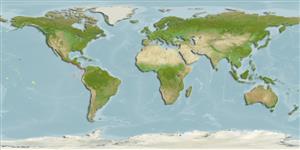Teleostei (teleosts) >
Eupercaria/misc (Various families in series Eupercaria) >
Haemulidae (Grunts) > Haemulinae
Etymology: Anisotremus: Greek, anisos = unequal + Greek, trema, -atos = hole (Ref. 45335).
More on authors: Jordan & Gilbert.
Environment: milieu / climate zone / depth range / distribution range
Ecology
Marine; demersal. Tropical; 25°N -
Eastern Pacific: Mexico to Peru.
Size / Weight / Age
Maturity: Lm ? range ? - ? cm
Max length : 30.0 cm TL male/unsexed; (Ref. 9114); common length : 25.0 cm TL male/unsexed; (Ref. 9114)
Body compressed and deep (depth contained 2.0 to 2.1 times in standard length); mouth small and terminal with thick, fleshy lips; dorsal fin with 12 spines and 15 to 16 soft rays (XII, 15-16); pectoral fins slightly longer than head, reaching origin of anal fin; lateral line with 50 to 54 scales; scale series above lateral line parallel to it; body entirely golden gray with an indistinct dark stripe from nape to base of pectoral fins; flanks indistinctly striated; pelvic fins almost black (Ref. 55763).
Benthic over hard, rock and rubble bottoms (Ref. 9114). Marketed fresh (Ref. 9114).
Life cycle and mating behavior
Maturity | Reproduction | Spawning | Eggs | Fecundity | Larvae
Distinct pairing during breeding (Ref. 205).
McKay, R.J. and M. Schneider, 1995. Haemulidae. Burros, corocoros, chulas, gallinazos, roncos. p. 1136-1173. In W. Fischer, F. Krupp, W. Schneider, C. Sommer, K.E. Carpenter and V. Niem (eds.) Guia FAO para Identification de Especies para lo Fines de la Pesca. Pacifico Centro-Oriental. 3 Vols. FAO, Rome. (Ref. 9114)
IUCN Red List Status (Ref. 130435)
Threat to humans
Harmless
Human uses
Fisheries: minor commercial
More information
ReferencesAquacultureAquaculture profileStrainsGeneticsElectrophoresesHeritabilityDiseasesProcessingNutrientsMass conversion
Tools
Warning: mysqli::__construct(): (HY000/1040): Too many connections in /var/www/html/includes/speciessummary.lib.php on line 2414
Can't connect to MySQL database fbquizv2. Errorcode: Too many connections
